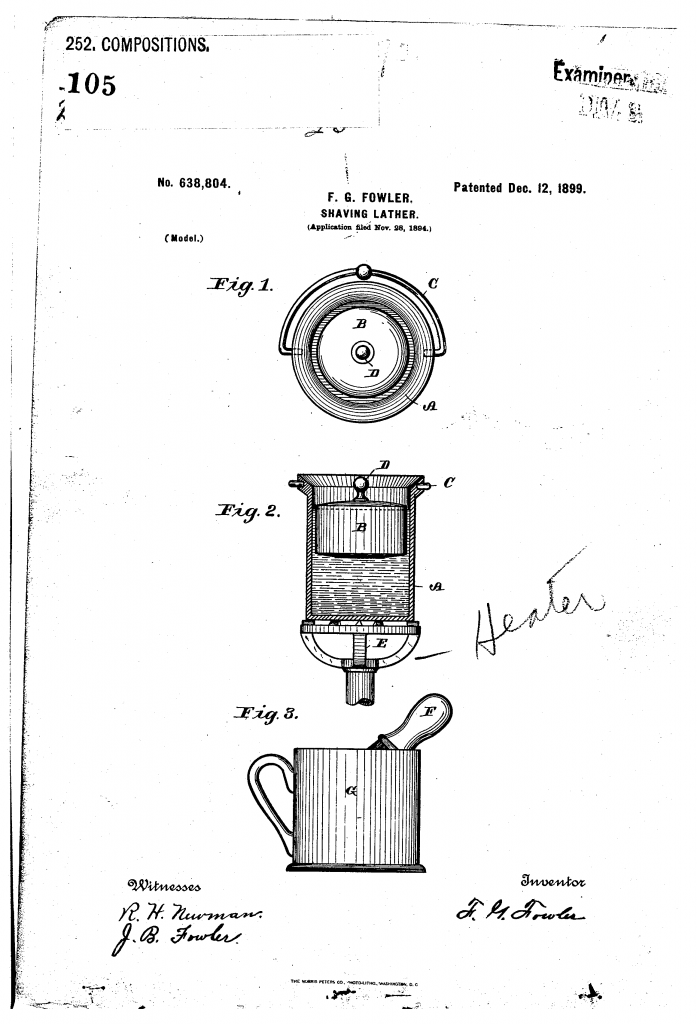Be it known that I, FRANK G. FOWLER, of Bridgeport, Connecticut, have invented certain new and useful Improvements Relating to Shaving-Lather, and I do hereby declare that the following is a full, clear, and exact description of the invention, which will enable others skilled in the art to make, practice, and use the same.
Frank G Fowler, in the ingress to US patent 638,804
Don’t you just hate how your lather causes your razor to get rusty and funky? No?
Well, it must have been a recurring problem in the 1890’s, because Mr Fowler got a patent for a device that would remedy the situation. He identified the culprit as being the water used to make lather. He had found that it contained in occlusion and in solution various gaseous and volatile substances. Among these were oxygen, carbonic acid,1 ammonia and other compounds. These substances, Mr Fowler claimed, stayed in the shaving lather and attacked the minute serrations of the razor blade. This dulled and corroded the blade, as well as irritating the skin.
The invention
The obvious solution would be to boil the water, since most of the substances Mr Fowler identified will evaporate at a lower temperature than water do. Once you take the water of the boil, well, it’s exposed to the atmosphere, and all the bad stuff leaps back in again. At least as far as the patent text is to be believed.
So the less obvious solution would be to boil the water but keep the harmful influences of the atmosphere away. And the non-obvious2 solution is a floating lid that almost but not quite covers the water. Oh, and call it a piston-float, not a lid. And the piston float should have a relative density of about 0.6. This would mean that a little less than half of the float would be over the water. If pushed down, it would bob back up again.

In addition to the piston float, which is clearly seen in the drawings, Mr Fowler suggested diffusing in the water a metallic dust which was electropositive to steel. The OCR of the patent is not great, but the PDF is clear enough to make out that he wanted to use zinc powder. This would react with the free oxygen in the water and form zinc-oxide, a compound that is mostly harmless to people.
How to use for making shaving lather
To use, the shaver would pour water into the cylindrical retaining vessel (A). He would add a bit of zinc, before placing the piston-float (B) on top. The heater (E) would heat the water to the boiling point. And then, according to the patent, the shaver would take it of the heat, push down the piston-float with his shaving brush (F) to soak it, and proceed to make lather in the normal way. In a shaving mug. Which may or may not contain who knows what kind of pollutants, germs, and corrosive elements…
Today we would simply buy distilled water instead.
Wrap up
Mt Fowler’s patent for shaving lather is not the first lather related patent I’ve had a look at. But all the previous ones – such as the improvement in shaving-mugs, the other improvement in shaving mugs, or this improved shaving mug – all dealt with the mug for making the lather in. And the antiseptic mugs I looked at a while ago were for barbers and disposable. Mr Fowler’s patent is the first one I’ve seen that attacks the problem from the watery end of things.
As usual, the full patent can be read at Google Patents. If you enjoy old shaving patents and other shaving related oddities, why not check out the rest I have on my blog?
Footnotes
- Carbonic acid – H2CO3 – is formed when carbon dioxide is dissolved in water.
- A patent have to cover a non-obvious idea. If the idea is considered obvious to “person having ordinary skill in the art”, you will not be granted a patent.

Pingback: A shaving cup for a neat freak - Wegian WetshavingWegian Wetshaving